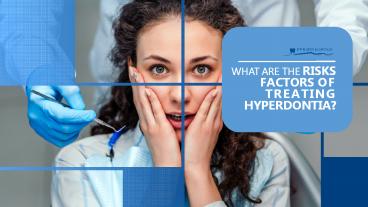What are the Risk Factors of Treating Hyperdontia - PowerPoint PPT Presentation
Title:
What are the Risk Factors of Treating Hyperdontia
Description:
Hyperdontia causes extra teeth to grow in an individual’s mouth. It can be easily diagnosed during an oral exam or x-ray. Also, in extreme cases, the extra tooth is noticeable and can cause pain while eating. It is good to consult your dentist for avoiding the risk factors associated with hyperdontia that are shown in this show. – PowerPoint PPT presentation
Number of Views:10
Title: What are the Risk Factors of Treating Hyperdontia
1
WHAT ARE THE RISKS FACTORS OF TREATING
HYPERDONTIA?
2
Having too many teeth is an oral condition called
hyperdontia.
3
Hyperdontia causes extra teeth to grow in an
individuals mouth.
4
Lets take a closer look at how this occurs and
whats available for help.
5
WHAT IS HYPERDONTIA?
It is a condition where an individual has too
many teeth in their mouth.
6
A child should have 20 primary teeth an adult
should have 32 teeth.
7
Extra teeth are often referred to as
supernumerary teeth.
8
HOW TO KNOW IF YOU HAVE HYPERDONTIA
In mild cases, an individual may never know that
they have extra teeth.
9
It is diagnosed only during an oral exam or x-ray.
10
In severe cases, extra teeth can be noticeable
can cause pain while eating.
11
It occurs in about 1 to 4 of the population
with most cases having one extra tooth.
12
COMMON CAUSES OF HYPERDONTIA
It is common in people having the following
conditions-
- Ehlers-Danlos Syndrome
- Gardners Syndrome
- Fabry Disease
- Cleidocranial Dysplasia
13
EHLERS-DANLOS SYNDROME
It causes easy bruising, scoliosis, loose
sometimes painful joints painful muscles.
14
GARDNERS SYNDROME
It is a rare disorder that causes colon growths,
skull growths and cysts.
15
FABRY DISEASE
People with this disease experience skin rashes,
painful hands feet, abdominal pain inability
to sweat.
16
CLEIDOCRANIAL DYSPLASIA
- It is a birth defect that affects the bone and
teeth. - A persons skull and collarbone are usually
poorly developed.
17
THE EXTRA TEETH
A distomolar tooth grows in the back of the mouth
line with your other teeth.
18
Paramolar teeth grow in the back of the mouth
next to the molars.
19
A mesiodens tooth grows next to your incisors
is the most common type of hyperdontia.
20
LETS DISCUSS YOUR OPTIONS
If you or your child has hyperdontia contact us
schedule an appointment.
21
Dental Group of Simi Valley is conveniently
located at 1720 E. Los Angeles Ave. Suite 202,
Simi Valley, CA 93065.
You can contact us at (805) 312-7596.
22
SOURCE https//www.dentalgroupofsimivalley.com/wh
at-are-the-risk-factors-of-treating-hyperdontia/































